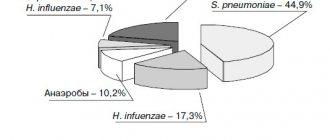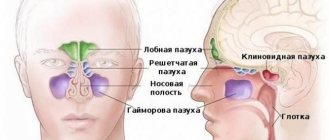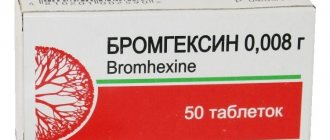Sinusitis is an inflammation of the mucous membrane of the maxillary (or maxillary) sinus.
We have two maxillary sinuses; they are located in the thickness of the maxillary bone on both sides of the wings of the nose. The paranasal sinuses (which, in addition to the maxillary sinuses, include two frontal sinuses, the ethmoid labyrinth and the sphenoid sinus) are designed to prepare inhaled air for further movement within the body (entering the lower respiratory tract). In the sinuses, the air is warmed and humidified. In addition, thanks to the sinuses, the weight of the facial part of the skull is reduced. The sinuses also play the role of a resonator, setting the timbre of our voice.
The sinuses open into the nasal cavity through small openings called anastomoses. This makes them vulnerable: when the nasal mucosa swells, the sinuses may become blocked. There are few nerve endings in the mucous membrane of the sinuses themselves, so the inflammatory process here can take place without causing pain until a certain point.
Chronic sinusitis
Chronic sinusitis is diagnosed if the inflammatory process in the maxillary sinuses continues for more than 4 weeks. In the chronic form of the disease, periods of relatively good health are followed by exacerbations, when the symptoms of sinusitis appear again.
Between exacerbations, the symptoms of sinusitis are usually mild. The temperature, as a rule, does not rise or rises slightly - up to 37−37.5 °C. The most indicative symptom of chronic sinusitis is attacks of dry night cough, which does not respond to traditional treatment. A cough is caused by phlegm running down the back of the throat.
Chronic sinusitis is very difficult to completely cure. Therefore, if you get sinusitis, you should immediately consult a doctor before the disease becomes chronic.
Causes of sinusitis
Most often, sinusitis occurs as a complication of colds and infectious diseases (such as influenza, ARVI). Reduced immunity, structural features of the nasal passages (for example, a deviated nasal septum), susceptibility to allergic rhinitis, and increased sensitivity of the vegetative-vascular system to irritants (the so-called vasomotor rhinitis) can contribute to the occurrence and development of sinusitis.
The inside of the sinuses is lined with a membrane that produces mucous secretion. If a person is healthy, the small amount of mucus produced is easily removed through the sinus anastomosis into the nasal cavity, and with this constant flow, microorganisms and dust particles that have entered there along with the air are removed from the sinuses.
As soon as a runny nose begins, the mucous membrane of the nasal cavity swells, sometimes including the mucous membrane of the anastomosis. The entrance to the sinus is blocked. If the swelling is significant, oxygen stops flowing into the sinus, creating favorable conditions for the development of anaerobic pathogenic microorganisms. Pressure increases in the sinus, a bursting sensation occurs, and then pain. Pathogenic bacteria produce toxins that, when released into the blood, can cause signs of general intoxication. Inflammation of the mucous membrane of the sinus itself develops, that is, sinusitis itself. The mucus turns into pus, which, having a more viscous consistency, even when the swelling has subsided, cannot leave the sinus naturally. Sometimes pus fills the entire sinus, and the severity of pain increases.
Typically, inflammation is not limited to just one sinus, but immediately affects both the maxillary and frontal sinuses, as well as the ethmoid labyrinth deep in the nose. In this case, they talk about polysinusitis (sinusitis is an inflammation of any paranasal sinus; sinusitis is a special case of sinusitis).
Sinusitis, which manifests itself in the form of isolated inflammation of only one sinus, may be of odontogenic origin, that is, be a consequence of inflammation in the dentofacial area. If the maxillary sinus has a significant volume, only a thin bone separates it from the tops of the tooth roots, and in some cases the tops of the tooth roots are adjacent directly to the mucous membrane of the sinus. In this case, advanced inflammation in the area of the four outermost upper teeth or unprofessional tooth extraction surgery can lead to infection of the maxillary sinus mucosa.
Viral
The causative agent of the disease is viruses, and it occurs against the background of viral infections (ARVI). This form of the disease is very similar to a cold, so in order to suspect the disease in time, you need to know the symptoms of viral sinusitis.
For example, the famous doctor E.O. Komarovsky believes that viral sinusitis occurs with any acute respiratory viral infection, since viruses entering the nose also penetrate the sinuses.
Treatment of viral diseases is largely related to the production of interferon and antibodies by the human body. The faster and more interferon and antibodies are produced, the faster the recovery and the easier the course of the disease.
Therefore you can:
- first get vaccinated against the most dangerous types of viruses, such as influenza;
- use antiviral drugs that stimulate the production of interferon, but it is important to make sure that the drug you choose has scientifically proven effectiveness, otherwise it will simply be wasted money and disappointed expectations;
- use the Vitafon medical device, which also promotes the production of interferon, which has been proven in the treatment of more dangerous viral diseases such as hepatitis.
With a viral disease, the main task is to prevent it from becoming bacterial. To do this, it is important to prevent mucus from thickening and drying out, as well as nasal congestion as a result of swelling.
This will help you avoid this:
- drinking plenty of water;
- ensuring an optimal indoor microclimate (temperature within 18-20 C, humidity 50-70%);
- regular checking and wet cleaning;
- removal of edema using the Vitafon device;
Temperature adjustment should primarily occur as a result of reducing the temperature of the heating batteries.
To increase the humidity in the room, special air humidifiers (air washers) are used.
If the nose is still blocked, it is necessary to use vasoconstrictor drugs, but not more than 3-5 days, otherwise drug-induced rhinitis may develop, which is difficult to treat.
With timely treatment, viral sinusitis goes away without a trace. If the disease is started, it easily becomes bacterial in nature.
Bacterial
The causative agents of this type of sinusitis are bacteria that can be aerobic (aerobic sinusitis) - this means that their development occurs with the supply of oxygen, and anaerobic (anaerobic sinusitis) - these bacteria develop without access to oxygen. Bacterial sinusitis can be acute and chronic, unilateral and bilateral.
Treatment depends on the stage and form of the disease; the complex always includes antibacterial drugs (antibiotics), vasoconstrictors, mucolytics, and herbal remedies. Also, if necessary, sinus lavage is prescribed using a YAMIK catheter and the “cuckoo” procedure. In many cases, puncture of the maxillary sinuses (puncture) is used.
Symptoms of sinusitis
Acute sinusitis is characterized by the following symptoms:
Runny nose
Sinusitis is characterized by a prolonged runny nose with purulent or mucous discharge. A normal runny nose should go away within 7-10 days. If the runny nose drags on and there is no improvement in the condition, then the inflammatory process has probably spread to the mucous membrane of the paranasal sinuses. One of the signs of a runny nose turning into sinusitis may be alternating congestion in the right and left nostrils.
More about the symptom
Morning sputum
Mucus from the sinuses flows into the nasopharynx, causing frequent expectoration and copious sputum production in the morning.
Sinus pain
A characteristic symptom of sinusitis is an unpleasant feeling of heaviness or pain in the cheek area. Sometimes not only the area of the inflamed sinus itself hurts, but also the teeth, eyes, and temples. The pain, less noticeable in the morning, intensifies in the evening. Pain also increases when bending forward.
Weakness
General weakness and fatigue with sinusitis are caused by produced toxins.
More about the symptom
Temperature
In acute sinusitis, the temperature may rise to 38°C or higher.
More about the symptom
Methods for diagnosing sinusitis
Diagnostic procedures for sinusitis are designed to determine the condition of the maxillary sinuses: the degree of swelling of the mucous membrane, the presence and level of fluid in the sinus. For this purpose the following are used:
X-ray of the sinuses
The radiography method of the paranasal sinuses is used most often.
More information about the diagnostic method
MSCT of the paranasal sinuses
A CT scan of the sinuses also uses X-rays. But it allows you to get a more detailed picture of bone structures. This diagnostic method is used, as a rule, for chronic sinusitis.
More information about the diagnostic method
Ultrasound of the sinuses
An ultrasound of the nasal sinuses is usually performed if an x-ray is undesirable (during pregnancy, examination of children, or during a repeat examination). Ultrasound can be performed using the Sinuscan ultrasound diagnostic device.
MRI of the sinuses
MRI of the sinuses is used if it is necessary to evaluate the condition of the sinus mucosa.
Sign up for diagnostics To accurately diagnose the disease, make an appointment with specialists from the Family Doctor network.
Rinsing the nose with Aqualor solutions
In the treatment of chronic sinusitis in adults and children, preparations for the sanitation of the nasal cavity, created on the basis of natural sea water, are successfully used. Aqualor products will be especially useful in the treatment of sinusitis during pregnancy, when many medications are prohibited.
During exacerbations, hypertonic solutions are effective: they reduce tissue swelling, have an antimicrobial effect, dissolve crusts and purulent mucous plugs. For infectious sinusitis, we recommend paying attention to hypertensive Aqualor Extra Forte. It contains chamomile and aloe extracts, known for their antiseptic properties.
During remission, regular rinsing of the nose with isotonic Aqualor Soft and Aqualor Norm helps remove bacteria and allergens.
Treatment methods for sinusitis
Treatment of sinusitis should be timely. It is very important to prevent the disease from becoming chronic and developing complications. Therefore, if symptoms of sinusitis appear, you should immediately consult a doctor.
Treatment of sinusitis in the “Family Doctor”
Removing pus from the paranasal sinuses
can be carried out
using the YAMIK sinus catheter
, which uses the creation of controlled pressure in the sinuses and nasal cavity. This is a painless and effective procedure. In cases where there is no other way to ensure the outflow of pus from the sinus, a puncture (or puncture) of the maxillary sinus is performed. The puncture is carried out with preliminary anesthesia and is performed using low-traumatic needles, which makes the operation painless.
When visiting a doctor in the early stages of the disease, there is usually no need for a puncture; washing and drug treatment are sufficient.
You can receive qualified medical care for sinusitis by contacting an ENT doctor at any of the Family Doctor clinics. Select a clinic that is located in the area of Moscow you need.
Treatment of sinusitis in pregnant women
During pregnancy, women's immunity decreases slightly. Therefore, a runny nose during pregnancy is a fairly common occurrence. And as a complication of a runny nose, sinusitis often develops.
Diagnosis and treatment of sinusitis in pregnant women has its own characteristics: X-rays and computed tomography of the head are not recommended, especially in the early stages. Certain medications (antibiotics) should not be used.
More information about sinusitis in pregnant women
Make an appointment Do not self-medicate. Contact our specialists who will correctly diagnose and prescribe treatment.
Rate how useful the material was
thank you for rating
"ENT clinic of Doctor Zaitsev"
Our clinic specializes in the treatment of ear, nose and throat diseases. The most modern equipment, our own techniques and experienced specialists are the three components that will allow you to treat acute sinusitis quickly, safely and effectively. Regular clients of our clinic notice that our prices remain at the 2013 level!
When the first signs of sinusitis appear, please do not delay visiting a doctor. Call and make an appointment - we are always ready to help you!









